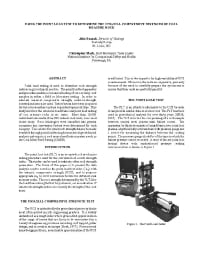Mining Publication: Using the Point Load Test to Determine the Uniaxial Compressive Strength of Coal Measure Rock
Original creation date: August 2000
Authors: J Rusnak, C Mark
NIOSHTIC2 Number: 20021059
Proceedings of the 19th International Conference on Ground Control in Mining, August 8-10, 2000, Morgantown, West Virginia. Peng SS, Mark C, eds., Morgantown, WV: West Virginia University, 2000 Aug; :362-371
Point load testing is used to determine rock strength indexes in geotechnical practice. The point load test apparatus and procedure enables economical testing of core or lump rock samples in either a field or laboratory setting. In order to estimate uniaxial compressive strength, index-to-strength conversion factors are used. These factors have been proposed by various researchers and are dependent upon rock type. This study involved the extensive load frame and point load testing of coal measure rocks in six states. More than 10,000 individual test results, from 908 distinct rock units, were used in the study. Rock lithologies were classified into general categories and conversion factors were determined for each category. This allows for intact rock strength data to be made available through point load testing for numerical geotechnical analysis and empirical rock mass classification systems such as the Coal Mine Roof Rating (CMRR).

NIOSHTIC2 Number: 20021059
Proceedings of the 19th International Conference on Ground Control in Mining, August 8-10, 2000, Morgantown, West Virginia. Peng SS, Mark C, eds., Morgantown, WV: West Virginia University, 2000 Aug; :362-371
- Application of the Coal Mine Roof Rating (CMRR) to Extended Cuts
- Comparison of Ground Conditions and Ground Control Practices in the United States and Australia
- Correlation of Sonic Travel Time to the Uniaxial Compressive Strength of U.S. Coal Measure Rocks
- Development and Application of the Coal Mine Roof Rating (CMRR)
- Factors Influencing Intersection Stability in U.S. Coal Mines
- In Situ Estimation of Roof Rock Strength using Sonic Logging
- Load and Deflection Response of Ventilation Stoppings to Longwall Abutment Loading: A Case Study
- New Developments with the Coal Mine Roof Rating
- Numerical Modeling Procedures for Practical Coal Mine Design
- Using the Coal Mine Roof Rating (CMRR) to Assess Roof Stability in U.S. Coal Mines